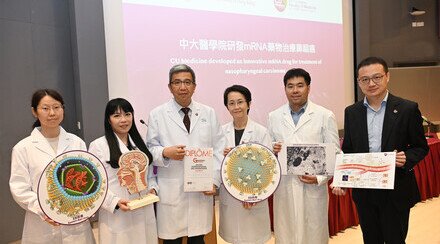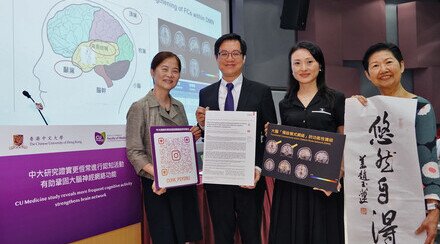CUHK Proves a Non-invasive Technology Can Successfully Cure Cerebral Arteriovenous Malformation
Researchers from the Department of Surgery, Department of Imaging and Interventional Radiology and Department of Clinical Oncology at The Chinese University of Hong Kong (CUHK) have proved that the non-invasive technology — linear accelerator radiosurgery can successfully cure cerebral arteriovenous malformation (AVM) in a collaborative research jointly conducted by the three departments since 1998. AVM is the leading cause of stroke in young people (aged 10 to 40). An estimate of 70 to 80 patients per year suffer AVM hemorrhage (ruptured blood vessels with bleeding inside the brain) in Hong Kong, which is associated with death in about one in five patients and disability in another one in five patients.

From Left: Mr Dennis Yuen Kan NGAR, Medical Physicist, Department of Clinical Oncology; Dr Michael Koon Ming KAM, Clinical Associate Professor (honorary), Department of Clinical Oncology; Prof George Kwok Chu WONG, Professor, Division of Neurosurgery, Department of Surgery and Dr Deyond Yung Woon SIU, Clinical Assistant Professor (honorary), Department of Imaging and Interventional Radiology jointly present their recent research findings on how a non-invasive technology can cure cerebral arteriovenous malformation.
Formed during brain development, AVM is a cluster of abnormal connecting vessels between arteries and veins. Patients may experience severe headaches or seizures, or suffer a stroke from a hemorrhage in the brain. The goal of treatment is to reduce this risk of fatal or debilitating hemorrhagic stroke. However, treatment can be difficult when AVM becomes severe or occurs in brain area with critical function.
Radiosurgery (RS) is a non-invasive treatment. Focused radiation beams are directed precisely to AVM in a single session. The mechanism of radiosurgery's action on AVM is believed to act on the endothelial cells lining its blood vessels. These cells tend to multiply after radiosurgery and produce clots which diminish blood flow through the tangle of vessels, thus AVM eventually becomes a harmless scar.
More than 100 AVMs had been treated using linear accelerator radiosurgery since 1998. The procedures are usually performed under local anesthesia. Typical hospital stay for radiosurgery is only 3 days, significantly shorter than that required for microsurgery and embolization. Most patients can return to their normal daily activity or work the day afterwards.

From Left: Mr Dennis Yuen Kan NGAR, Medical Physicist, Department of Clinical Oncology; Prof George Kwok Chu WONG, Professor, Division of Neurosurgery, Department of Surgery; Dr Deyond Yung Woon SIU, Clinical Assistant Professor (honorary), Department of Imaging and Interventional Radiology and Dr Michael Koon Ming KAM, Clinical Associate Professor (honorary), Department of Clinical Oncology.
The CUHK researchers have subsequently completed a review of the 70 AVM radiosurgeries among 100 cases (41 male; 29 female; mean age 31 years old) with more than 2 years of clinical and radiological follow-up. High success rate of over 86% and less than 10% complication rate were shown. There was no related death. The results were recently published in the Journal of Clinical Neuroscience. With the successful introduction of advanced neuroimaging techniques and new frameless image guided robotic technologies in 2009, more AVMs can now be safely and successfully treated with radiosurgery.


























































